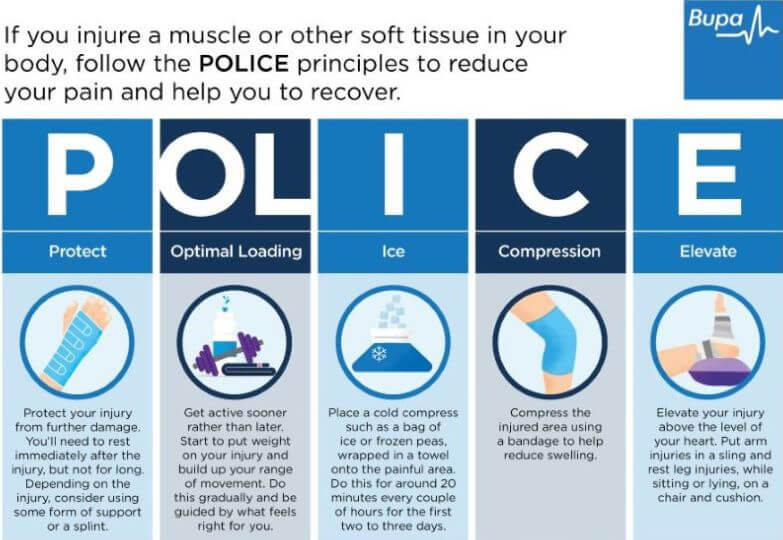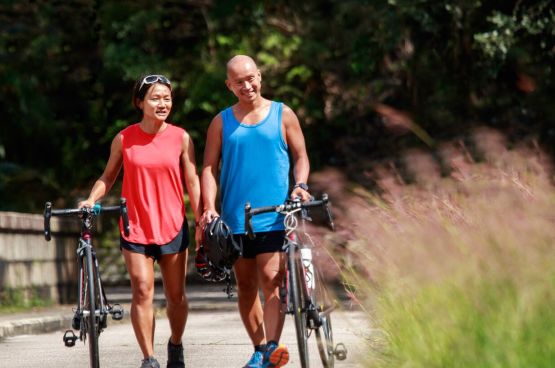Knee strengthening exercises
Strengthening exercises can help to protect your knees from injury and keep them strong. They can also help you to recover from a knee injury. We should all look after our knees, but it’s particularly important if you’re a keen runner. Here, I describe different types of exercises that can help to strengthen your knees. And, I provide advice on how to look after a knee injury.

How can exercises help to strengthen our knees?
Regular strengthening exercises can help to build up the muscles in and around our knees. This can help improve the support around them, which can help to prevent injury and pain.
When starting any new exercise, you should always begin slowly and gradually. And, only do as much as you can manage without feeling any pain. Speak to your doctor or physiotherapist beforehand if you have an existing knee injury, or if:
- your knee pain is severe
- you feel that your knee is locked or ‘giving way’
- the pain lasts for a few weeks
What types of exercises can strengthen knees?
Below is a series of exercises that you can try at home or in the gym. It’s a good idea to spend five minutes warming up before performing these exercises. You could try 5 to 10 minutes of walking or cycling, for example.
Bodyweight squat
- Stand upright with your feet hip-width apart and your toes pointing forwards.
- With your back straight, chest out, and shoulders back and down, slowly squat downwards.
- Don’t let your knees move in towards each other.
- Squat downwards as far as you comfortably can, then straighten your legs to return to standing.
- Aim for 3 sets of 10 repetitions.
Watch our video on bodyweight squats.
Single-leg squat
- Stand on one foot with your toes facing forwards.
- Lower your body by bending your standing leg at the knee. Keep your kneecap in line with your foot – try not to move it from side-to-side.
- Go as low as you can without any pain, then straighten your leg to return to standing.
- Aim for 3 sets of 10 repetitions on each leg.
Watch our video on single-leg squats.
Stabilisation lunge
- Stand with your legs apart, with one foot in front of the other.
- Gradually bend one of your knees to a 90 degree angle, before slowly rising up.
- Keep your front knee in line with your foot.
- Aims for 3 sets of 10 repetitions on each leg.
Watch our video on stabilisation lunges.
Glute bridge
- Lie on your back with both knees bent at about 90 degrees, with both feet flat on the floor.
- Slowly lift your bottom up by pushing through your heels and squeezing your glutes.
- Keep your knees in line with your feet.
- Try not to arch your back and slowly lower your bottom down towards the floor.
- Aim for 3 sets of 10 repetitions.
Watch our video on glute bridges.
Sitting knee extension
- Sit on the floor with one leg straight and the other leg bent at about 90 degrees.
- Place a rolled-up towel under your knee on your straight leg for support.
- Keeping your toes pointing upwards, clench the muscle at the front of your thigh and push down on to the towel so your knee straightens and your heel lifts off the floor.
- Hold for 10 seconds and slowly lower.
- Aim for 3 sets of 10 repetitions on each leg.
Watch our video on sitting knee extensions.
How often should I do these exercises?
A physiotherapist will be able to give you more information on how often you should do these exercises. This is because it depends on your individual circumstances, and knee health. But, it’s recommended that adults take part in some form of activity to help strengthen their muscles at least twice a week.
I have a knee injury, how should I look after it?
If you’ve injured your knee, you should follow the ‘POLICE’ principles. These are a set of steps to help reduce your pain and help you recover.
- P – protect. Protect your injury from further damage. Rest immediately after the injury but not for long. Consider using some form of support or crutches.
- OL – optimal loading. Get active sooner rather than later. Start to put weight on your knee and build up your range of movement. Do this gradually, and only do what feels right for you.
- I – ice. Place a cold compress such as a bag of ice or frozen peas wrapped in a towel onto your knee. Do this for around 20 minutes every few hours for the first two to three days to help reduce swelling.
- C – compression. Compressing your knee with a bandage will also help to limit swelling.
- E – elevation. Elevate your knee above your heart to help reduce swelling. Sit or lie on a chair and use a cushion to raise your leg.
Infographic: POLICE principles
Bupa's POLICE infographic (PDF, 0.5 MB) below illustrates the ‘POLICE principles’ to reduce your pain and help you to recover.

If your knee injury is serious, or isn’t getting better, seek immediate medical attention. This is especially important if you think you could have a broken bone (fracture).
What should I avoid doing with a knee injury?
For the first few days after hurting your knee, you can help to prevent further damage by avoiding ‘HARM’. This stands for the following.
- Heat. Avoid hot baths, showers, saunas, heat rubs or heat packs.
- Alcohol. Don’t drink alcohol as it can slow down your recovery and increase your chances of hurting yourself again.
- Running. Don’t run or do other types of moderate activity as this may cause further damage.
- Massage. Massaging the area can cause more swelling and bruising, so avoid this for the first day or two.
Infographic: HARM principle
Bupa's HARM infographic (PDF, 0.6 MB) below illustrates the ‘HARM principle' of things you should avoid doing in the first three days after your injury.

Our knees are an important part of our bodies, so it’s important to take good care of them. Always follow your doctor or physiotherapist’s advice. And, make sure to get checked out if you’re experiencing any pain or discomfort in your knees.
If you have a muscle, bone or joint problem, our direct access service aims to provide you with the advice, support and treatment you need as quickly as possible. If you’re covered by your health insurance, you’ll be able to get advice from a physiotherapist usually without the need for a GP referral. Learn more today.
-
Sources Sources
- Carbohydrates: food fact sheet. BDA - the Association of UK Dietitians. bda.uk, published September 2021
- Wholegrains: food fact sheet. BDA - the Association of UK Dietitians. bda.uk, published May 2022
- Starchy foods (carbs). British Nutrition Foundation. nutrition.org.uk, last accessed October 2022
- Human nutrition. Essential nutrients. Carbohydrates. Encyclopaedia Britannica. britannica.com, last accessed October 2022
- Glycaemic Index (GI): Food Fact Sheet. BDA - the Association of UK Dietitians. bda.uk, published January 2020
- The Eatwell guide. Public Health England. gov.uk, published September 2018
- Dietary reference values and food-based dietary guidelines. Oxford Handbook of Nutrition and Dietetics (3 edn, online). Oxford Academic. academic.oup.com, published April 2020
- Diabetes. Oxford Handbook of Nutrition and Dietetics (3 edn, online). Oxford Academic. academic.oup.com, published April 2020
- Diabetes - type 2. Scenario: Management – adults. NICE Clinical Knowledge Summaries. cks.nice.org.uk, last revised October 2022
- Fields H, Ruddy B, Wallace MR, et al. Are low-carbohydrate diets safe and effective? J Am Osteopath Assoc 2016; 116: 788-93. doi:10.7556/jaoa.2016.154
- Healthy weight loss. British Nutrition Foundation. nutrition.org.uk, last revised 19 October 2016
- Obesity. Oxford Handbook of Nutrition and Dietetics (3 edn, online). Oxford Academic. academic.oup.com, published April 2020
- Carbohydrates and Health. Scientific Advisory Committee on Nutrition. Public Health England. gov.uk, published July 2015
About our health information
At Bupa we produce a wealth of free health information for you and your family. This is because we believe that trustworthy information is essential in helping you make better decisions about your health and wellbeing.
Our information has been awarded the PIF TICK for trustworthy health information. It also follows the principles of the The Information Standard.

More exercise and fitness articles
Did you find our advice helpful?
We’d love to hear what you think. Our short survey takes just a few minutes to complete and helps us to keep improving our healthy lifestyle articles.
Legal disclaimer
This information was published by Bupa's Health Content Team and is based on reputable sources of medical evidence. It has been reviewed by appropriate medical or clinical professionals and deemed accurate on the date of review. Photos are only for illustrative purposes and do not reflect every presentation of a condition.
Any information about a treatment or procedure is generic, and does not necessarily describe that treatment or procedure as delivered by Bupa or its associated providers.
The information contained on this page and in any third party websites referred to on this page is not intended nor implied to be a substitute for professional medical advice nor is it intended to be for medical diagnosis or treatment. Third party websites are not owned or controlled by Bupa and any individual may be able to access and post messages on them. Bupa is not responsible for the content or availability of these third party websites. We do not accept advertising on this page.







